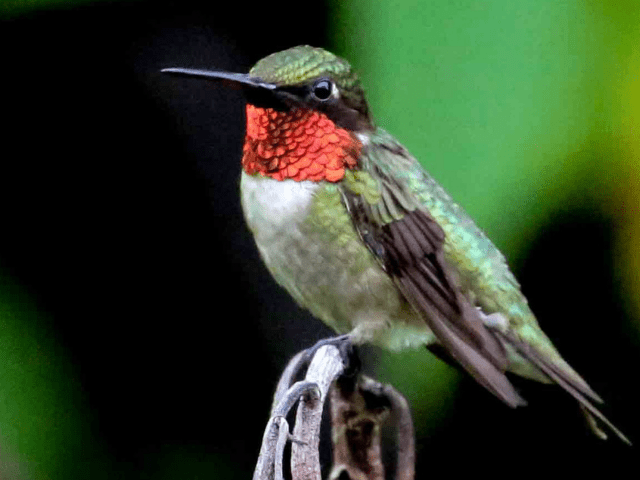A pleasant hello to my friendly bird lovers, more specifically the Michiganders!
Hummingbirds...
They are indeed one-of-a-kind creatures with their long beaks and wings that fly backward.
Michigan is a beautiful country, but sadly, some know little about these beautiful birds found in the area.
Over the past years, people started finding more and more species. Let's take some time and look at the different types of hummingbirds in Michigan.
As you may know, only one hummingbird species is regular, but it's not a zero percent chance to discover other ones. Besides, the rare occurrence makes the experience even more extraordinary.
Michigan Hummingbird: The Rare And The Regular
1. Ruby-Throated Hummingbird
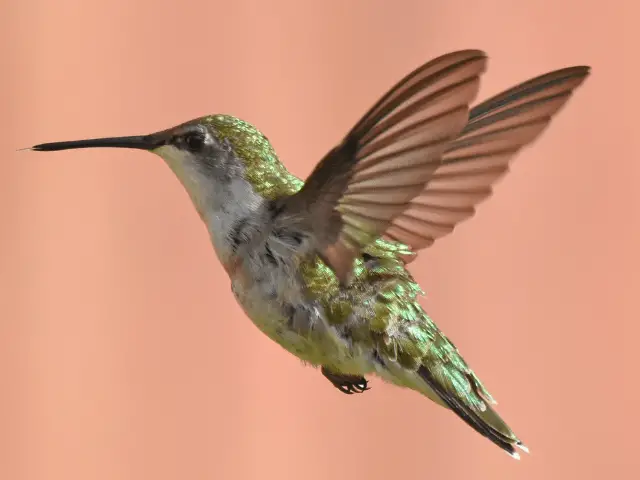
Archilochus colubris
Sighting in Michigan: Breeding Season (March-July, peak at May)
Famous for: the only regular bird in Michigan
Here we have the ruby-throated hummingbird, a common sight to see but just as remarkable. Try to come during the peak of the breeding season for bountiful birds. Being a fan of nectar, you can find them among meadows, more specifically on vibrant-colored flowers.
So if you’re a resident wanting to attract these natives, why not have tubular plants like honeysuckles in your garden. Trees and shrubs are good, too; females like building their nests naturally. They are rather comfy with us humans, so no need to worry.
Although, they might be a wee competitive with each other for food.
Like most hummingbirds, females look a bit dull with their green, black, and grey back and tail feathers, but I still find them pretty.
Although we know hummingbirds to have small and short legs, these species have miniature ones!
2. Rufous Hummingbird
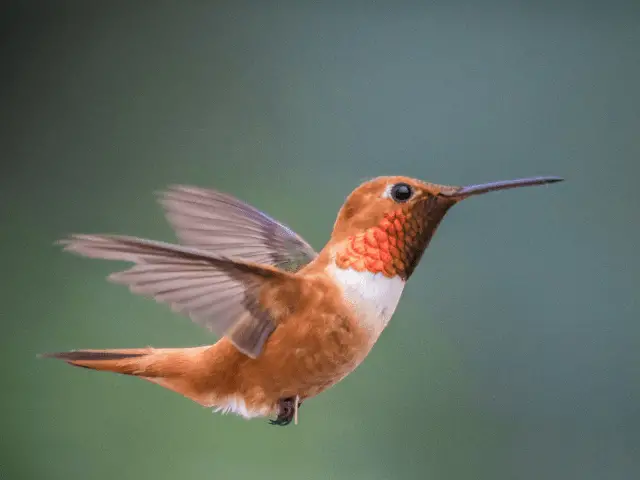
Selasphorus Rufus
Sighting in Michigan: May to September, north
Famous for: feistiest hummingbird in North America
Rufous hummingbirds in Michigan are rare, but you’d consider them the second most common bird you’re likely to see. They might come around during fall or nearing winter.
You’ll also find the males having a reddish-orange throat like the ruby-throated hummingbird. To distinguish them, look for their rusty orange tone across their back and white chest.
Females have a green-colored back with some orange on their chest and white portions on their body and feather tips.
But beware that they can be a tad competitive and aggressive. They won’t think twice about fighting other hummingbirds, even those larger than them, for their food or favorite flower for nectar.
3. Anna's Hummingbird
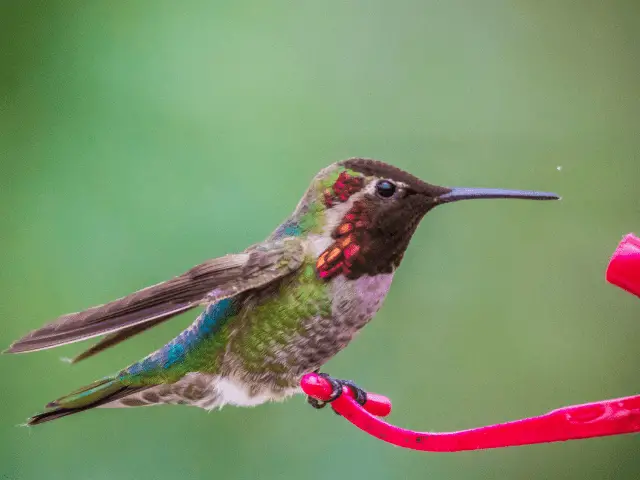
Calypte anna
Sighting in Michigan: occasional (two recorded in 2010)
Famous for: pink head and mating habits
Here we have Anna’s Hummingbirds. Very common on the Pacific coast, they are rarer to find than Rufous hummingbirds, but there are still sights of them from the past years.
Considering their size, they are medium for a hummingbird with also larger heads.
To identify them, look for a pretty pink-headed bird, a unique sight to see, indeed. The bodies are also slightly greenish.
You might try observing their mating habits.
4. Green Violetear Hummingbird
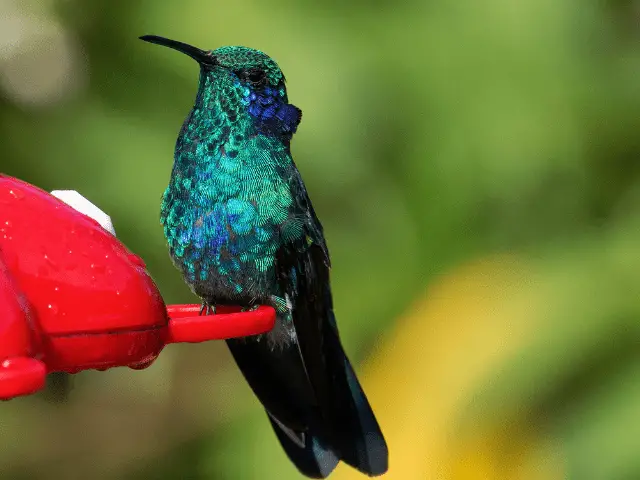
Colibri thalassinus
Sighting in Michigan: seasonal findings, southeast of the state
Famous for: being nomadic and far wanderers
Next on our list are the Green Violetear hummingbirds, also called the Mexican Violetear. They are rare but still casual in the area. Being nomadic, people commonly see them from Mexico to Nicaragua, but chances are you'll see some in Michigan.
They usually like temperate forests or wherever there are bountiful flowers. You might see them in your feeders, too.
You'll also find them medium-sized for a hummingbird; they're consequently heavier as well.
Their feathers highlight a colorful array of green plumage, with some violet-blue highlights particularly at the side of their heads, hence the name. You'll also find the tail a bit squared with some dark blue strikes at the end.
Apart from the slight dull in shades, you can distinguish the females by being smaller in size.
5. Broad-Billed Hummingbird
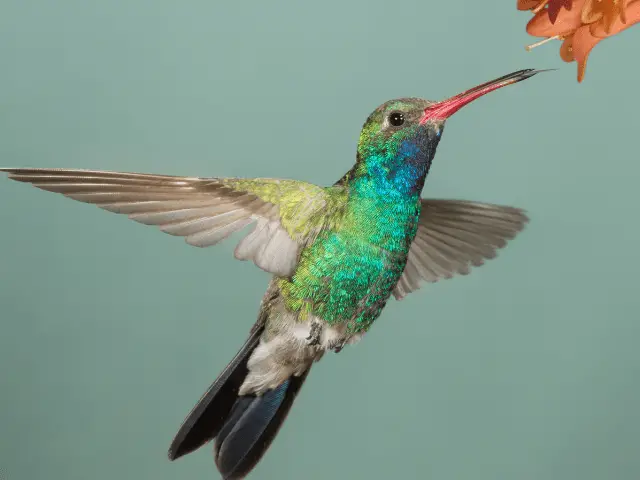
Cynanthus latirostris
Sighting in Michigan: July and December, south of the state
Famous for: Distinguishable by male’s bright red and broad beak
These Broad-billed Hummingbirds might be more difficult to find; they usually live in Mexico and have occurred in Michigan twice (1996 and 2000).
You could find them in open areas like meadows. In case you do, they’ll be easily distinguishable with the male’s bright red and, as you'd expect, broad beak.
Beautifully colored, the males have green-colored backs and chests with dark blue throats. As usual, females tend to be duller with grayer tones and a white stripe over the eye.
What an observation this will be, so keep an eye out; you might be a lucky one.
6. White-Eared Hummingbird
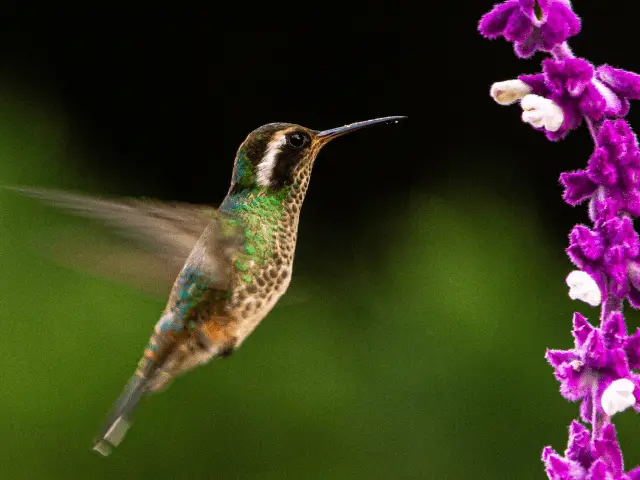
Basilinna leucotis
Sighting in Michigan: Only one sighting in 2005; eastern border of the state
Famous for: white stripes across faces
The world gives you a great deal of luck if you ever cross paths with the white-eared hummingbird in Michigan. Like most rare hummingbirds on our list, they are most common in Mexico.
You’ll find them as colorful birds, males more attractive, with black to violet heads and turquoise-green bodies.
They are most likely to fly in mountainous forests. Try to find a male perched on a branch, trying to attract a female with their melodious voice.
Fun Fact: Gain more insight as you read about finches in Michigan -- another avian species you surely would hate not to love!
Frequently Asked Questions
Which time of the year do you most likely find hummingbirds in Michigan?
The chances you’ll find different hummingbird species in Michigan are highest around May to early August; that's during spring to nearing fall.
If you want to know more when to hung feeders and attract hummingbirds, watch this:
When do hummingbirds leave Michigan?
Most leave between late August to the start of September, but there might still be some late migrators that appear 2-3 weeks after.
When do hummingbirds return to Michigan?
The hummingbirds start coming back as early as March and some in April, or when winter starts to end.
Where do you find hummingbird nests in Michigan?
Michigan hummingbirds like to build their nests in shrubs and forked branches in trees, and regular birds in deciduous or coniferous ones.
We live in Michigan. Is it legal to keep hummingbirds here as pets?
No, you can't. A law in the United States prevents us from keeping migratory birds -- hummingbirds included. You may set up some bird feeders for them, though.
They aren’t as easy to care for as most think. Only their natural lifestyle provides them with some necessities they need to live. So unless you have a valid permit, kindly give these Michigan hummingbirds the freedom you’d want for yourself, too.
Final Thoughts
Among the different types of hummingbirds in Michigan, which do you aim to see the most?
Chances to capture the sight of two or more of the birds on our list are rare as rubies. But don’t give up!
You might receive a prize for finding a rare hummingbird flying across lovely Michigan.
So if you’re a passionate being living in the state or interested in taking a trip, grab a pen and paper. Make a list of the six species. I challenge you to cross out as much as you can, or who knows, add more to the awaiting list.

